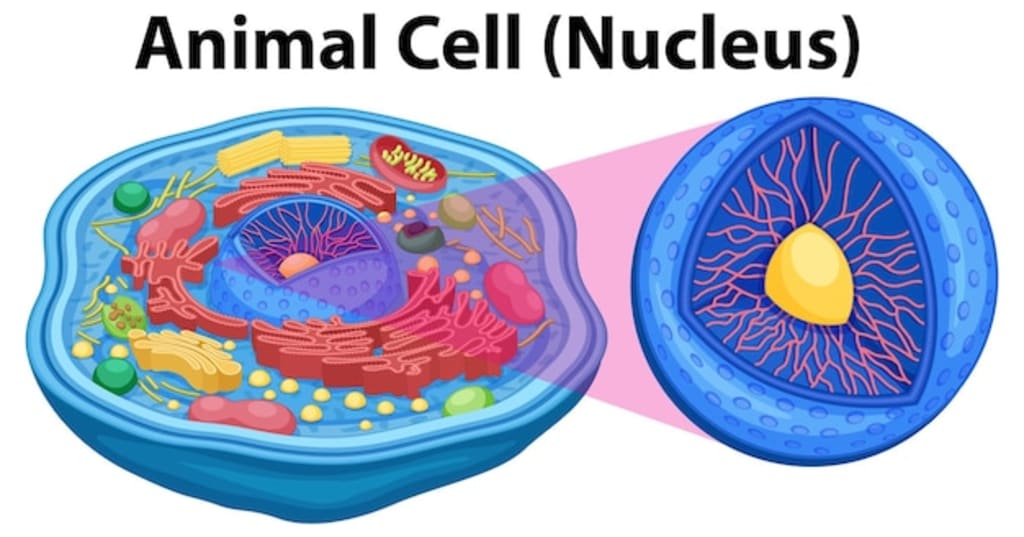Nucleus of an animal cell
The nucleus of an animal cell is like the brain of the cell

The nucleus of an animal cell is like the brain of the cell, housing its genetic material and regulating many of its functions. Within this small but mighty organelle lies the blueprint for life, encoded in strands of DNA. Let's delve deep into the intricacies of the animal cell nucleus, exploring its structure, function, and significance in cellular biology
Structure of the Animal Cell Nucleus:
The nucleus is typically the most prominent organelle within an animal cell, easily visible under a microscope. It is surrounded by a double membrane called the nuclear envelope, which separates its contents from the rest of the cell's cytoplasm. The nuclear envelope contains pores that allow for the passage of molecules, facilitating communication between the nucleus and the cytoplasm.
Within the nucleus, the genetic material is organized into structures called chromosomes. These chromosomes consist of long strands of DNA wrapped around proteins called histones. The DNA-protein complex is further organized into structures called chromatin, which condenses to form visible chromosomes during cell division.
Another essential component of the nucleus is the nucleolus, a dense region where ribosomal RNA (rRNA) synthesis and assembly of ribosomes occur. The nucleolus is not membrane-bound but is composed of proteins and nucleic acids.
*Function of the Animal Cell Nucleus:
The nucleus serves several critical functions that are essential for the survival and functioning of the cell:
1. **Genetic Information Storage:** The primary function of the nucleus is to store the cell's genetic material in the form of DNA. This DNA contains the instructions for synthesizing proteins and controlling cellular activities.
2. **Transcription:** Transcription is the process by which genetic information encoded in DNA is copied into RNA molecules. This process occurs in the nucleus, where the DNA is transcribed into messenger RNA (mRNA) by the enzyme RNA polymerase.
3. **RNA Processing:** After transcription, mRNA undergoes processing in the nucleus, including capping, splicing, and polyadenylation. These modifications prepare the mRNA for translation into proteins in the cytoplasm.
4. **Ribosome Synthesis:** As mentioned earlier, the nucleolus is responsible for synthesizing ribosomal RNA (rRNA) and assembling ribosomes. Ribosomes are the cellular machinery responsible for protein synthesis.
5. **Cellular Regulation:** The nucleus plays a crucial role in regulating gene expression and controlling cellular activities. This regulation occurs through mechanisms such as DNA methylation, histone modification, and the binding of transcription factors to DNA.
6. **Cell Division:** During cell division, the nucleus undergoes a series of highly coordinated events to ensure accurate segregation of genetic material into daughter cells. This process involves the condensation and distribution of chromosomes, as well as the breakdown and reformation of the nuclear envelope.
Significance of the Animal Cell Nucleus:
The nucleus is often referred to as the "control center" of the cell because of its central role in regulating cellular activities. Its significance extends beyond the individual cell to the entire organism, as genetic information encoded in the nucleus determines an organism's traits and characteristics.
Understanding the structure and function of the nucleus is essential for various fields of biology, including genetics, developmental biology, and molecular biology. Research on the nucleus has led to significant advancements in areas such as cancer biology, stem cell research, and gene therapy.
Additionally, the nucleus serves as a model system for studying fundamental biological processes such as transcription, translation, and DNA repair. Insights gained from studying the nucleus in animal cells have broad implications for understanding cellular function in diverse organisms, including humans.
In summary, the animal cell nucleus is a remarkable organelle with critical roles in storing genetic information, regulating gene expression, and controlling cellular activities. Its structure and function are intricately linked to the overall functioning of the cell and have profound implications for biological research and human health.






Comments
There are no comments for this story
Be the first to respond and start the conversation.